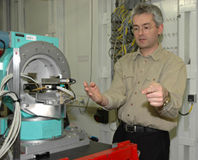- Home
- News
- General News
- Users from the Max-Planck...
Users from the Max-Planck Institute for Metals Research install a unique Surface and Interface diffraction endstation at the ESRF
11-03-2005
Share
When users come to the ESRF, they normally stay around three or four days: they arrive, they do their experiment and they return with all their data to their home institute. This is true for most of the users, but the team from the Max-Planck Institute for Metals Research in Stuttgart is an exceptional case. They are spending six weeks at the synchrotron, not only to carry out experiments, but also to install a unique diffraction endstation on the High Energy Scattering Beamline, ID15. Thanks to this new spectrometer, scientists will be able to obtain high resolution diffraction data not only from surfaces but also from deeply buried interfaces.

The team from Max-Planck Institute. From left to right: Sebastian Schöder, Harald Reichert, John Okasinski and Frank Renner.
The ESRF is the only place in Europe where this instrument can be used, since it needs a brilliant high energy x-ray source. The instrument can be used in two different modes, where either the sample or the incident beam is moved to change the diffraction angles. Specially-developed optics can keep the samples fixed while moving the incident beam. This option turns the instrument into a liquid spectrometer which can reach very high vertical momentum transfer.

H. Reichert explains how the new spectrometer works.
It took the team of scientists six months to build this instrument. First they developed a prototype whose size was a tenth of the real one. Although the prototype was a delicate instrument, the researchers were then able to test the device and obtain results that have already been published. The instrument is now open for users and all those interested can benefit from the new heavy-duty diffraction endstation on ID15.



